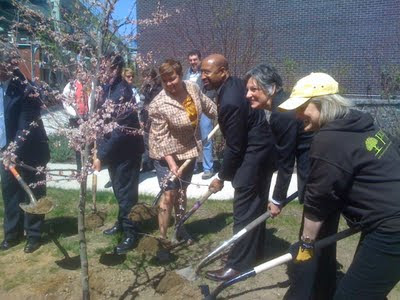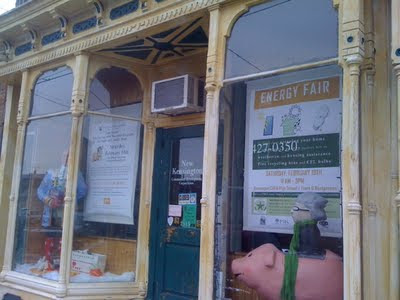 Image by brunosan via Flickr Image by brunosan via Flickr |
| The Texas flag flies in Houston. |
A green building store in the Lone Star State shows how to build a healthy home, and a good business too.
Recently, I received a visit from my cousin Amanda Claire DeMers of Houston, who was in Philadelphia to see some of our great historic sites. I've known that she's been involved with the acclaimed store,
New Living, which is an eco-smart, green building hub for Houston's sustainability sphere, and a certified "B" corporation. So after a little family catch-up chat at
Johnny Brenda's restaurant and pub here in the Fishtown neighborhood of Philly, we discussed some of the innovative work that she and the store has been doing back in her hometown.
How long have you worked for New Living?
I have been at New living for two months, but New Living has been around for two years. I came in with a background in environmental policy, my Master's was on fisheries management, so completely not to do with design or retail or marketing or anything like that. But I met the owners and we got along. I came on and have been working retail there for the past couple months, but I'll be doing some PR and marketing for them - press releases and such, social media maintenance, and then a lot of events in environmental education.
Tell us about New Living - what they do, their history.
New living is a store in Houston and their niche is healthy green building and home. They sell all kinds of home-building products, like counter-tops, flooring, and they also sell organic mattresses and bedding. And then next door, which is actually part of our store but has a different storefront, is a shop called The Green Painter. That opened up six or seven month ago as a split off from New Living, and they sell no-
VOC paints, non-toxic glues, wood stains, and concrete stains.
So all of our products are non-toxic and they're all environmentally friendly. But a lot of the emphasis is on the non-toxic. Much of that, to some degree, is because Houston hasn't necessarily been a very green conscious city, and when New Living moved in they thought they were going to be this sort of green store with a straight environmental message. Houston wasn't as responsive to that message as they envisioned, so they started learning more about
indoor air quality and health and promoted those ideas, which sometimes goes along with environmental certifications like
LEED, though sometimes it's independent. In fact, sometimes it's the opposite - a lot of LEED certification buildings trap the air inside, so they've really embraced the non-toxic banner and it seems to have resonated well.
You bring up a good point. As a trained energy auditor, my focus is often on sealing the "envelope of the home" to improve energy efficiency. We check for high CO levels in furnaces, mold, lead paint, asbestos, pet dander and other potential indoor air quality threats, but there are a multitude of contaminants to consider. We have to be very conscious of toxins as we tighten up homes.
 Image by Scoobyfoo via Flickr Image by Scoobyfoo via Flickr |
| Non-toxic materials |
Yes, and we can start that by not bringing as many toxins into the building process, which is the significance for having formaldehyde-free flooring, and surfaces that are antimicrobial and naturally bacterial resistant and don't contain chemical dyes, and wool carpets that don't contain synthetic coatings on them. When you don't bring these toxins into the home to begin with, you start at a much easier place. Then you can begin to manage it with something like an air filter, either for a whole home or maybe just one room. We also sell air filters and water purifying systems.
It seems like it takes more than just standard marketing and offering healthy green products to make your business thrive. You've moved into channels of New Media to advocate your concept. Tell us more about the advocacy side.
They've always done pretty well as a business, because, for whatever reasons, Houston as a city is doing well. So we do have customers that have the money to spend on quality home products. The key is making sure we educate people about why our products are the better choice. And there will be a greater role for the educational and advocacy component through time.
We're actually not just a store, we're a certified "B" corporation or
benefit corporation, which is a certain way that we're chartered to serve the long term interests of the shareholders and to help solve social, economic and environmental problems, rather than just immediate returns to investors.
So this falls in line with business concepts that have been described as an emerging new economic model: A business that's sustainable and socially responsible, but profitable too.
Certain states already have programs in place that to certify and encourage B corporations. And hopefully, someday, it would be nice if there was some sort of tax advantage too. So say, instead of being a non-profit or, well, an oil corporation - somewhere between BP and Oxfam - we could find a place where we received some government benefit of taking on these problems.
Aside from providing non-toxic home products and educational outreach, what other services does New Living offer? Do you work directly with contractors?
Yes, and that's something that's really cool about our business. Downstairs is the store and showroom, but upstairs is sort of this green business incubator, where we have several green designers, an urban renewal realty program, green architects, and a solar company. It's really a hub of green activity in Houston and we've worked hard together to make a green scene here.
That's interesting. Houston doesn't come to mind as top on the list of cities with a strong sustainability community, like say here in Philly, where our mayor has been pushing to make this the greenest city in the nation. How would you compare Houston to others?
Some people say that it's behind major cities, but it's caught up pretty fast. Because we have some money here, it's been able to escalate more quickly.
Actually, one of our main customer components is moms. Sometimes even mom's who's husbands work for a big oil company or in the chemical industry, but they've read some of the popular
Michael Pollan,
Bill McKibben type books and they're saying "you know, I don't want to bring bad things into my home." Just like the local foods and organic foods movement caught on big partly because moms were afraid of what they were feeding their kids, we're hoping that non-toxic mattresses and organic flooring will follow.
I hope so too. Thanks for stopping by and giving a word to our readers about New Living and your great city. I hope you were able to take in some of the famous sites here as well.--D.A DeMers.





















